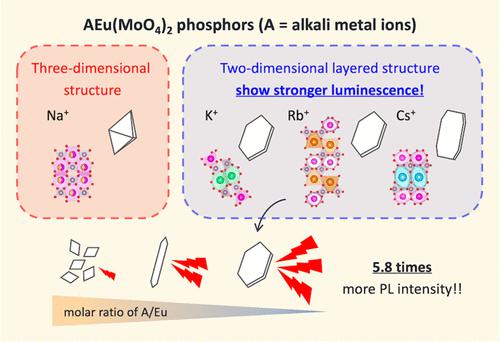当前位置:
X-MOL 学术
›
Cryst. Growth Des.
›
论文详情
Our official English website, www.x-mol.net, welcomes your feedback! (Note: you will need to create a separate account there.)
Acquisition of Emissive Single-Crystalline AEu(MoO4)2 (A = Na, K, Rb, and Cs) Double Molybdates by One-Pot Hydrothermal Synthesis: Relationship between Particle Morphology and Photoluminescence Properties
Crystal Growth & Design ( IF 3.8 ) Pub Date : 2024-04-04 , DOI: 10.1021/acs.cgd.4c00332 Suzuka Noda 1 , Takuya Hasegawa 1 , Tomoyo Goto 2, 3 , Yasushi Sato 4 , Ayahisa Okawa 1 , Shu Yin 1, 5
Crystal Growth & Design ( IF 3.8 ) Pub Date : 2024-04-04 , DOI: 10.1021/acs.cgd.4c00332 Suzuka Noda 1 , Takuya Hasegawa 1 , Tomoyo Goto 2, 3 , Yasushi Sato 4 , Ayahisa Okawa 1 , Shu Yin 1, 5
Affiliation

|
Emissive double molybdates, AEu(MoO4)2 (A = Na, K, Rb, Cs), have garnered significant attention due to the diversity of crystal structures depending on the ionic radius of A+ ions. However, the relationship between particle morphology and photoluminescence properties has not been reported for them. In this study, single-crystalline double molybdates were successfully synthesized by varying the molar ratio of A/Eu through a one-pot hydrothermal route without an annealing process. This approach allowed for the creation of a variety of crystal structures and particle morphologies. The two-dimensional (2D) layered materials of KEu(MoO4)2, RbEu(MoO4)2, and CsEu(MoO4)2 exhibit a luminescence intensity stronger than that of the scheelite-type NaEu(MoO4)2 with a three-dimensional (3D) framework structure because the layered structure can activate a higher concentration of Eu3+ ions due to the suppression of migration of excitation energy between Eu3+ ions. By varying the amount of A sources added, the morphologies were drastically changed, and their luminescence intensity was improved. Particularly, the particle morphologies of RbEu(MoO4)2 changed from rhombic nanoplate-like to rod-like and, finally, to hexagonal plate-like particles. The luminescence intensity achieved up to 5.8 times higher, attributed to the crystal growth along the in-plane direction of RbEu(MoO4)2 including the [EuO8] layer.
中文翻译:

通过一锅水热合成获得发射性单晶 AEu(MoO4)2(A = Na、K、Rb 和 Cs)双钼酸盐:颗粒形貌与光致发光性能之间的关系
发射性双钼酸盐,A Eu(MoO 4 ) 2 ( A = Na, K, Rb, Cs),由于晶体结构的多样性(取决于A +离子的离子半径)而引起了人们的广泛关注。然而,颗粒形态与光致发光性质之间的关系尚未见报道。在本研究中,通过一锅水热路线改变A /Eu的摩尔比,无需退火过程,成功合成了单晶双钼酸盐。这种方法可以创建各种晶体结构和颗粒形态。 KEu(MoO 4 ) 2、RbEu(MoO 4 ) 2和CsEu(MoO 4 ) 2的二维(2D)层状材料表现出比白钨矿型NaEu(MoO 4 ) 2更强的发光强度三维(3D)框架结构是因为层状结构由于抑制了Eu 3+离子之间的激发能的迁移而可以激活更高浓度的Eu 3+离子。通过改变A源的添加量,形态发生了巨大的变化,并且其发光强度也得到了提高。特别是,RbEu(MoO 4 ) 2的颗粒形貌从菱形纳米板状变为棒状,最后变为六角板状颗粒。由于晶体沿着包含[EuO 8 ]层的RbEu(MoO 4 ) 2的面内方向生长,发光强度达到了5.8倍。
更新日期:2024-04-04
中文翻译:

通过一锅水热合成获得发射性单晶 AEu(MoO4)2(A = Na、K、Rb 和 Cs)双钼酸盐:颗粒形貌与光致发光性能之间的关系
发射性双钼酸盐,A Eu(MoO 4 ) 2 ( A = Na, K, Rb, Cs),由于晶体结构的多样性(取决于A +离子的离子半径)而引起了人们的广泛关注。然而,颗粒形态与光致发光性质之间的关系尚未见报道。在本研究中,通过一锅水热路线改变A /Eu的摩尔比,无需退火过程,成功合成了单晶双钼酸盐。这种方法可以创建各种晶体结构和颗粒形态。 KEu(MoO 4 ) 2、RbEu(MoO 4 ) 2和CsEu(MoO 4 ) 2的二维(2D)层状材料表现出比白钨矿型NaEu(MoO 4 ) 2更强的发光强度三维(3D)框架结构是因为层状结构由于抑制了Eu 3+离子之间的激发能的迁移而可以激活更高浓度的Eu 3+离子。通过改变A源的添加量,形态发生了巨大的变化,并且其发光强度也得到了提高。特别是,RbEu(MoO 4 ) 2的颗粒形貌从菱形纳米板状变为棒状,最后变为六角板状颗粒。由于晶体沿着包含[EuO 8 ]层的RbEu(MoO 4 ) 2的面内方向生长,发光强度达到了5.8倍。



























 京公网安备 11010802027423号
京公网安备 11010802027423号